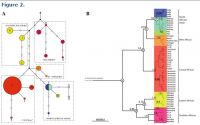|

Lion spelled CTAG
In a recent publication, Ross Barnett of Durham University and co-authors refined our understanding of both lion genetics and the dynamics of lion movements over the past millennia. Using mitochondrial (maternally inherited) DNA from 14 lions representing a number of extinct populations, their conclusions are highly interesting.
The samples were extracted from museum specimens of several now extinct lion populations in North Africa and Iran, and even included two lions from around 1400AD that were part of the menagerie at the Tower of London. The main conclusions were as follows:
- Eastern/southern Africa is most likely the evolutionary cradle of modern-day lions.
- A major division took place about 125,000 years ago, resulting in a group composed of eastern and southern African lions and another group of western, central, northern African and Asian lions. This latter group split again about 61,000 years ago into a central African group and one that includes lions from western and northern Africa and Asia.
- The final split between Asian lions and northern Africa lions only occurred about 21,000 years ago. This is interesting as lion fossils that are much older have been found in Iran and Israel. This implies that there has always been considerable genetic contact among lions across a wide region including northern Africa, the Middle East and Central Asia, the extremes of which are over 8,000 km apart. Such contact then ceased at around that date, perhaps an indication of increasing levels of anthropogenic influences – remember that sheep were domesticated about 13,000 years ago and agriculture began about 12,000 years ago indicative of relatively dense human populations in the Middle East.
- These various splits among the five genetic “clades” of lions
 can be traced back to rapid climatic changes taking place in Africa during the Pleistocene, including several cycles of high rainfall followed by high aridity. Associated vegetational changes likely split lion populations into geographically isolated subpopulations that genetically diverged from each other. can be traced back to rapid climatic changes taking place in Africa during the Pleistocene, including several cycles of high rainfall followed by high aridity. Associated vegetational changes likely split lion populations into geographically isolated subpopulations that genetically diverged from each other.
- The genetic results again establish the uniqueness of western African lions that unfortunately remain in legislative limbo while they should be classified as highly endangered. Only one reasonably large population of 350 individuals remains in the W-Arly-Pendjari transfrontier area of Niger, Benin and Burkina Faso. The total number of remaining western African lions is little more than 400 animals.
- Northern African lions, also known as Barbary lions, are extinct. A number of zoos claim to maintain a group of “Barbary” lions derived from the Moroccan Royal Menagerie, but their (maternal) genetics do not resemble those of the museum specimens collected before their extinction from places like Tunisia and Algeria – and the Tower of London lions. The authors suggest that instead of using “Barbary” zoo lions in any attempt to restore northern African lions, those reintroductions would better genetically mimic original Barbary lions if the new colonists were drawn from Indian lion populations.
- The authors caution that their conclusions would be strengthened by confirmation with data from nuclear DNA.
Despite this and previous studies pointing out the clearly distinctive genetics of western African lions and their ever-decreasing populations, organizations like the IUCN and CITES refuse to consider any special levels of protection. In fact, lions are still allowed to be trophy hunted in Benin and Burkina Faso – the latter country exported 55 lion trophies (males) between 2007 and 2010 and Benin exported 11 lion trophies (males) between 2010 and 2012. This cannot go on – with approximately 350 lions of both sexes and all ages remaining in that one small population of a critically endangered group of lions, why are such offtakes still tolerated by CITES?
Also, the study indicates that lions in Central Africa also require special conservation status. Today, small and scattered populations remain in northern Cameroon, Central African Republic, Chad, and perhaps South Sudan. With the exception of Cameroon, these remaining range states are among the most unstable nations in the world – which does not bode well for conservation of their remaining wildlife. A very optimistic estimate suggests that maybe 600 central African lions remain, although no population surveys of any scientific credibility have ever been conducted in the region except for Cameroon.
Lions are the only large cat species not listed on Appendix 1 of CITES. Lion conservation is grossly underfunded and conflicted by several international conservation organizations stubbornly insisting that continued trophy hunting is “good” for conservation. Few African nations have rigorous national lion conservation plans in place, and the latest CITES periodic review of African lions is an embarrassment.
Of the 15 range states that bothered to supply information, lions are already extinct or virtually extinct in 9 of them (Gabon, Ghana, Guinea, Cote d’Ivoire, Mali, Senegal, Rwanda, Nigeria and South Sudan).
Unless we do much more and quite quickly, Indian lions, which are treasured and therefore much better protected, might be called on in future to repopulate all of Africa.
Picture credit: anthgen.wordpress.com
If you have not already signed up to our mailing list, you can add your name here and keep up to date with our ongoing work and, most importantly, DONATE to support our work to conserve the remaining fragile lion populations. Thank you.
|




 can be traced back to rapid climatic changes taking place in Africa during the Pleistocene, including several cycles of high rainfall followed by high aridity. Associated vegetational changes likely split lion populations into geographically isolated subpopulations that genetically diverged from each other.
can be traced back to rapid climatic changes taking place in Africa during the Pleistocene, including several cycles of high rainfall followed by high aridity. Associated vegetational changes likely split lion populations into geographically isolated subpopulations that genetically diverged from each other. 